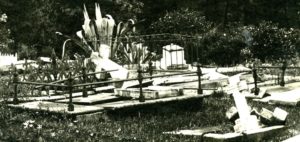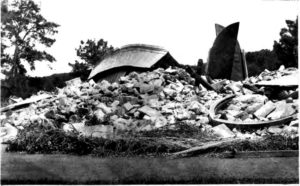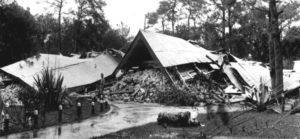By Uma Purkayastha
 ‘Doomsday’ struck Shillong, the newborn capital of the erstwhile undivided Assam, on June 12, 1897, snuffing out many lives and destroying almost all dwellings. Today it is the 125th year of that deadly incident of natural calamity.
‘Doomsday’ struck Shillong, the newborn capital of the erstwhile undivided Assam, on June 12, 1897, snuffing out many lives and destroying almost all dwellings. Today it is the 125th year of that deadly incident of natural calamity.Many mothers lost their infants and heard their cries from under the debris but were unable to rescue them. Panicked and hapless people had to take shelter in the open fields of Jail Road, Polo Ground, etc., ignoring heavy showers and chilly winds. The tremor continued with intervals for a few days, and the suffering of distressed people knew no bounds. Much of Shillong was flooded with lake water and overflowing brooks, and the water became undrinkable.
 A report prepared by the government of that time on the disaster reads: “The Assam earthquake of 1897 occurred on 12 June 1897, Saturday in Assam, British India at 11:06 UTC, and had an estimated moment magnitude of 8.2-8.2. It resulted in approximate 1,542 human casualties and caused catastrophic damage to infrastructures. Damage from the earthquake extended into Calcutta, where dozens of buildings were severely damaged, with some buildings partially collapsing. Trembles were felt across India, reaching as far as Ahmedabad and Peshawar. Seiches were also observed in Burma.”
A report prepared by the government of that time on the disaster reads: “The Assam earthquake of 1897 occurred on 12 June 1897, Saturday in Assam, British India at 11:06 UTC, and had an estimated moment magnitude of 8.2-8.2. It resulted in approximate 1,542 human casualties and caused catastrophic damage to infrastructures. Damage from the earthquake extended into Calcutta, where dozens of buildings were severely damaged, with some buildings partially collapsing. Trembles were felt across India, reaching as far as Ahmedabad and Peshawar. Seiches were also observed in Burma.”In Shillong, the earthquake took place at about 5:11 pm on June 12. The shock was preceded by a rumbling noise from beneath that lasted for about 3 minutes. The actual earthquake lasted about two-and-a-half minutes. This noise was likened to a thousand ships’ engines thumping away in the midst of a storm at sea. The shocks were so severe and prolonged that everything was levelled to the ground.
 F. Smith of the Geological Survey of India, who was stationed in Shillong at the time, said the earthquake was so violent that the whole of the damage was done in the first 10 or 15 seconds of the shock. He reported that all stone buildings collapsed, and about half of ikra-built houses (wooden frames, reed walls covered with plaster) were ruined, but plank houses (wooden frames covered with plank walls, resting unattached on the ground) were untouched. Many people lost their lives at the Secretariat, the military lines and the bazaar. The London Times reported the death of 27 people in Shillong, 13 of them crushed to death in the Government Press. However, a year later, Luttman-Johnson reported the loss of 10 lives at the Printing Press. The London Times also mentioned about 750 people perishing in an unnamed district town. This town probably was Cherrapunji where a landslide wrecked the Cherrapunji railway and caused 600 deaths.
F. Smith of the Geological Survey of India, who was stationed in Shillong at the time, said the earthquake was so violent that the whole of the damage was done in the first 10 or 15 seconds of the shock. He reported that all stone buildings collapsed, and about half of ikra-built houses (wooden frames, reed walls covered with plaster) were ruined, but plank houses (wooden frames covered with plank walls, resting unattached on the ground) were untouched. Many people lost their lives at the Secretariat, the military lines and the bazaar. The London Times reported the death of 27 people in Shillong, 13 of them crushed to death in the Government Press. However, a year later, Luttman-Johnson reported the loss of 10 lives at the Printing Press. The London Times also mentioned about 750 people perishing in an unnamed district town. This town probably was Cherrapunji where a landslide wrecked the Cherrapunji railway and caused 600 deaths. On August 10, 1897, the Times published letters from the residents of Shillong. Rev. G.M. Davis was quoted as saying that his church became a heap of stones in less than one minute. The water burst the bounds of the lakes making them absolutely dry within seconds. There was a sulphury smell in the air coming out of fissures in the ground. He saw huge stones on the steps of his house literally bubbling up and down. McCabe, the Inspector-General of Police, who was sick and in bed was found crushed on his bed after an hour’s digging of his collapsed bungalow.
On August 10, 1897, the Times published letters from the residents of Shillong. Rev. G.M. Davis was quoted as saying that his church became a heap of stones in less than one minute. The water burst the bounds of the lakes making them absolutely dry within seconds. There was a sulphury smell in the air coming out of fissures in the ground. He saw huge stones on the steps of his house literally bubbling up and down. McCabe, the Inspector-General of Police, who was sick and in bed was found crushed on his bed after an hour’s digging of his collapsed bungalow.There were also several reports from Shillong in Luttman-Johnson’s paper. In one report, a young lady mentioned that there were aftershocks almost every 10 minutes on the night of June 12 and during the day on the 13th. Another letter was from a lady who was in a house that came crushing on her but she miraculously survived.
The deputy commissioner of Shillong narrated the havoc in Shillong. Since he was unable to contact Guwahati by telegraph, he had to send two constables to go to Guwahati, 63 miles away, on foot to gather information from there. He worked through the night of June 12, supervising rescue operations [Ref: 1897 Assam earthquake from Wikipedia]
The late Sushila Dutta, the mother of Suprava Dutta, a professor at Lady Keane College, had recollected her terrible experience of the furious moments of the earthquake at her young age.
“It was Saturday at 5 pm. All schools and offices had a half-holiday and so, my husband was at home. I had a high fever and doctor Kamala Charan Dutta examined me at home and prescribed medicines. Prasanna Babu, a very close friend of my husband was also present there. My little girl of one year was playing on the floor in my bedroom. Suddenly, a violent tremor! A violent jerk with a tremendous rumbling sound! Our house was moving and collapsing! I panicked and tried to get my little daughter to me. But within a blink of an eye, the house collapsed and I discovered myself thrown outside onto the compound, and doctor babu grasping my little daughter was helplessly crying for rescue from half underground. It was an unbearable scene!
“The tremor continued with full intensity as I was crying and trying to rescue my child. My husband and our servants, with spade and axe, cleared the debris and rescued them very tactfully from a very critical condition. We had to take shelter in the Jail Road field. The tremor continued for almost three days at intervals. Many mothers lost their children, and heard their cries from beneath the rubbles but failed to rescue them despite all attempts. That deadly earthquake left an indelible mark in my memory.” [Translated from ‘Shillong-er Smriti’ by Sushila Sundari Dutta published in ‘Netaji Pathagar Golden Jubilee Souvenir’]
Her narration revealed that after the disastrous earthquake, many seismologists from home and abroad visited Shillong. Prof. Asuri from Japan advised the local authorities to construct light buildings with wooden planks, etc., in Shillong instead of concrete buildings. Since then, Assam-type buildings began coming up in Shillong and other earthquake-prone areas in Assam.
Shillong today is rapidly being developed with multi-storied RCC buildings replacing the old Assam-type structures. The collapse of the steel dome of the new Assembly building at Mawdiangdiang should be a warning for the city’s planners. If incessant rain could inflict damage to the Assembly building and other new structures such as the Inter-State Bus Terminus, one shudders to think what may happen if an 1897-like earthquake strikes Meghalaya again.



